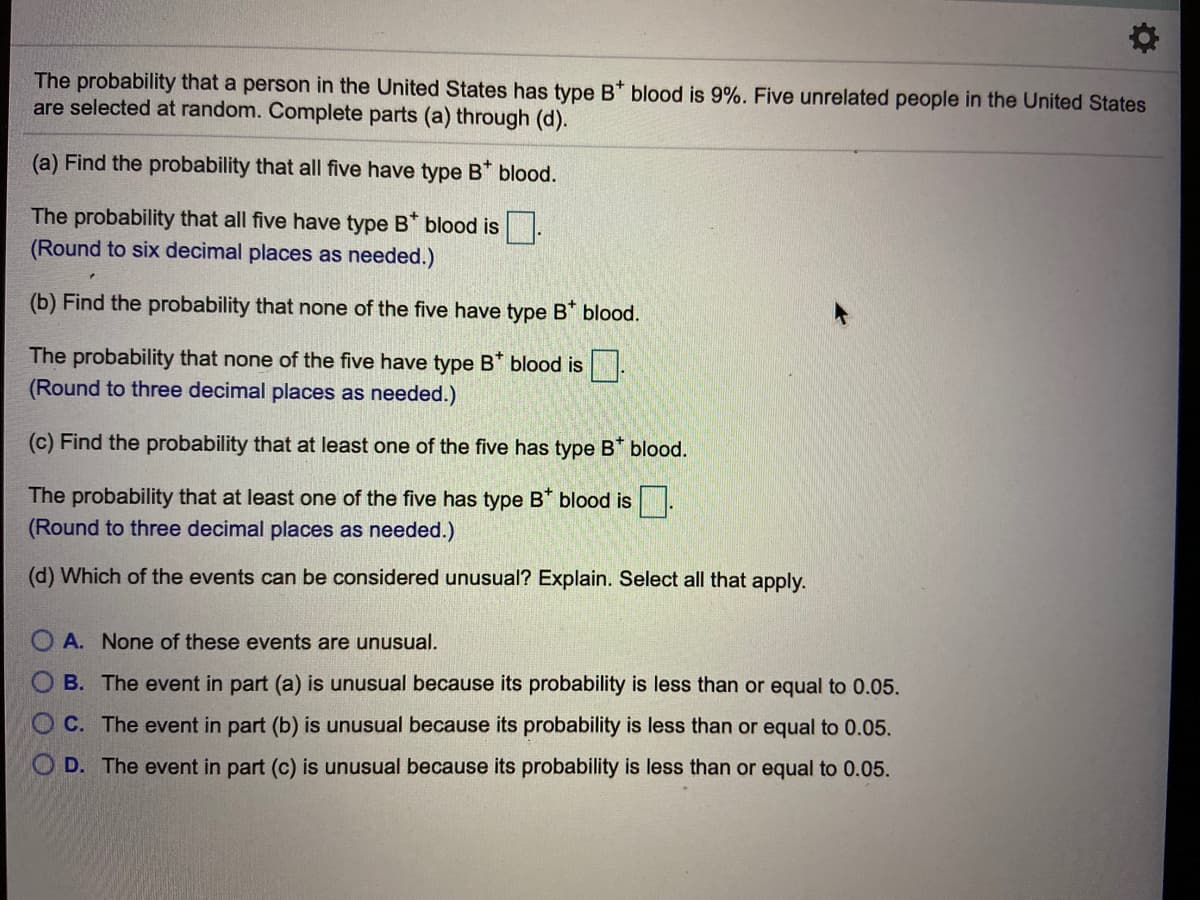The probability that a person in the United States has type B* blood is 9%. Five unrelated people in the United States are selected at random. Complete parts (a) through (d). (a) Find the probability that all five have type B* blood. The probability that all five have type B* blood is. (Round to six decimal places as needed.) (b) Find the probability that none of the five have type B* blood. The probability that none of the five have type B* blood is. (Round to three decimal places as needed.) (c) Find the probability that at least one of the five has type B* blood. The probability that at least one of the five has type B* blood is. (Round to three decimal places as needed.) (d) Which of the events can be considered unusual? Explain. Select all that apply. O A. None of these events are unusual. OB. The event in part (a) is unusual because its probability is less than or equal to 0.05. C. The event in part (b) is unusual because its probability is less than or equal to 0.05. D. The event in part (c) is unusual because its probability is less than or equal to 0.05.
The probability that a person in the United States has type B* blood is 9%. Five unrelated people in the United States are selected at random. Complete parts (a) through (d). (a) Find the probability that all five have type B* blood. The probability that all five have type B* blood is. (Round to six decimal places as needed.) (b) Find the probability that none of the five have type B* blood. The probability that none of the five have type B* blood is. (Round to three decimal places as needed.) (c) Find the probability that at least one of the five has type B* blood. The probability that at least one of the five has type B* blood is. (Round to three decimal places as needed.) (d) Which of the events can be considered unusual? Explain. Select all that apply. O A. None of these events are unusual. OB. The event in part (a) is unusual because its probability is less than or equal to 0.05. C. The event in part (b) is unusual because its probability is less than or equal to 0.05. D. The event in part (c) is unusual because its probability is less than or equal to 0.05.
Chapter8: Sequences, Series,and Probability
Section8.7: Probability
Problem 4ECP: Show that the probability of drawing a club at random from a standard deck of 52 playing cards is...
Related questions
Question
100%

Transcribed Image Text:The probability that a person in the United States has type B* blood is 9%. Five unrelated people in the United States
are selected at random. Complete parts (a) through (d).
(a) Find the probability that all five have type B* blood.
The probability that all five have type B* blood is
(Round to six decimal places as needed.)
(b) Find the probability that none of the five have type B* blood.
The probability that none of the five have type B* blood is.
(Round to three decimal places as needed.)
(c) Find the probability that at least one of the five has type B* blood.
The probability that at least one of the five has type B* blood is.
(Round to three decimal places as needed.)
(d) Which of the events can be considered unusual? Explain. Select all that apply.
O A. None of these events are unusual.
O B. The event in part (a) is unusual because its probability is less than or equal to 0.05.
O C. The event in part (b) is unusual because its probability is less than or equal to 0.05.
O D. The event in part (c) is unusual because its probability is less than or equal to 0.05.
Expert Solution
This question has been solved!
Explore an expertly crafted, step-by-step solution for a thorough understanding of key concepts.
This is a popular solution!
Trending now
This is a popular solution!
Step by step
Solved in 2 steps

Knowledge Booster
Learn more about
Need a deep-dive on the concept behind this application? Look no further. Learn more about this topic, statistics and related others by exploring similar questions and additional content below.Recommended textbooks for you


Algebra & Trigonometry with Analytic Geometry
Algebra
ISBN:
9781133382119
Author:
Swokowski
Publisher:
Cengage

Algebra and Trigonometry (MindTap Course List)
Algebra
ISBN:
9781305071742
Author:
James Stewart, Lothar Redlin, Saleem Watson
Publisher:
Cengage Learning


Algebra & Trigonometry with Analytic Geometry
Algebra
ISBN:
9781133382119
Author:
Swokowski
Publisher:
Cengage

Algebra and Trigonometry (MindTap Course List)
Algebra
ISBN:
9781305071742
Author:
James Stewart, Lothar Redlin, Saleem Watson
Publisher:
Cengage Learning

College Algebra (MindTap Course List)
Algebra
ISBN:
9781305652231
Author:
R. David Gustafson, Jeff Hughes
Publisher:
Cengage Learning